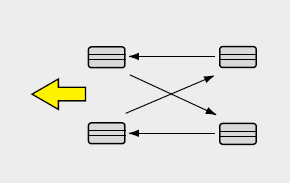Tire rotation
To equalize tread wear, it is recommended that the tires be rotated every 7,500 miles (12,000 km) or sooner if irregular wear develops.
During rotation, check the tires for correct balance.
When rotating tires, check for uneven wear and damage. Abnormal wear is usually caused by incorrect tire pressure, improper wheel alignment, outof- balance wheels, severe braking or severe cornering. Look for bumps or bulges in the tread or side of tire. Replace the tire if you find either of these conditions. Replace the tire if fabric or cord is visible. After rotation, be sure to bring the front and rear tire pressures to specification and check lug nut tightness.

Disc brake pads should be inspected for wear whenever tires are rotated.
NOTICE
Rotate radial tires that have an asymmetric tread pattern only from front to rear and not from right to left.
WARNING
• Do not use the compact spare tire for tire rotation.
• Do not mix bias ply and radial ply tires under any circumstances. This may cause unusual handling characteristics that could result in death, severe injury, or property damage.
See also:
Operating the manual transaxle
Your Hyundai's manual transaxle has a conventional
shift pattern. This shift pattern is imprinted
on the shift knob. The transaxle is fully
synchronized in all forward gears so shifting to
eithe ...
A Cabin That Matches the Exterior's Promise
The Elantra's exterior sets high design expectations, but the cabin gets a
fair dose of style itself. It's stylish in numerous ways, from the simple yet
elegant ventilation system knobs to the sle ...
ABS Service Reminder Indicator (SRI) (If Installed)
When the key is turned to the "ON" position, the Anti-Lock Brake System SRI will
come on and then go off in a few seconds. If the ABS SRI remains on, comes on while
driving, or does no ...


